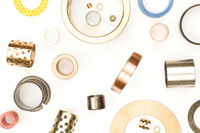
Posted to News on 21st Nov 2017, 00:00
Choosing the right bearing material for the application
Choice is good. Choice is healthy. Having options allows us to select the most relevant, the most efficient, the most cost-effective, the most attractive, and the most compatible option. Looking at bearing choice in particular, Craig Clydesdale of Bowman International explores the benefits of product choice and the folly of making “one size fits all” assumptions when it comes to bearing materials.

Unless one is purchasing a pair of socks, a “one size fits all” approach is rarely auspicious. Sartorial convenience aside, choice is what people want. We want to be presented with options and make our own decisions based on what is best for us. This is particularly apt in the bearings industry today. Choice allows businesses to select the most efficient solution for their specific projects.
Since the very first bearing was patented by the British inventor Philip Vaughan in the 18th century, plain bearings have been made from a multitude of materials to suit a vast range of applications. Typical materials have been wood, bronze, steel/composite, ceramic, glass, sapphire and plastic to name but a few. The list is endless. Today the most prevalent materials are bronze, metal composites and plastic. Each of these materials has its own unique characteristics which lend them to being more suitable than others for certain applications.
For example sintered bronze bearings are durable and have good load bearing capabilities, are impregnated with lubricant, can withstand high temperatures, run at high speeds and have excellent corrosion resistance. Hard rolled bronze bearings are durable and can take high loads, can withstand high temperatures, need lubrication, can run at medium to high speeds and have excellent corrosion resistance.
Plastic bearings have good sliding properties, but are limited on load and temperature and are not good when subjected to high loads when stationary for long periods. They do have excellent corrosion and chemical resistance. Steel composite bearings mostly are of the wrapped type, are usually self-lubricated, can take high loads, can withstand high temperatures and can run at medium to high speeds. Exposure to corrosion needs to be addressed.
On all projects, multiple considerations are made regarding the bearing application conditions and just what is the best solution to handle such conditions. Temperature, load, lubrication, contamination, speed and interval of use are just a few of these considerations. After these application deliberations, regard needs to be paid to things like ease of maintenance, lubrication and unit cost. The luxury of being able to choose the precise material that will be able to withstand application conditions, lends itself to easy maintenance (or indeed no maintenance) and comes within budget is not simply convenient but indeed vital to the success of the overall project.
There can be inherent dangers in talking to a supplier who can only offer a single material solution. However reputable the manufacturer, if that material is unsuitable for the particular application – for example because extreme load is causing the bearings to deform after periods of inactivity – then what might the consequences be? It could be a source of great cost, and no little embarrassment for the project manager – who now needs to remove the original bearings and seek a more suitable alternative.
Different applications will always require different materials. There is no “one size fits all” range of bearings that is suitable for all applications. If we go back to our clothing analogy for a moment, it is obvious that leather is a fantastic material for all manner of apparel, but there are more appropriate materials when a manufacturer is producing shirts or hosiery.
The point that should to be seriously addressed by engineers and buyers is the need to ensure that when enquiring of manufactures or suppliers, that the advice they receive is objective. Attempting to “shoe-horn” a single material option into an application where something different is the more suitable option will rarely end well, and the “one type fits all” assumption can lead to serious design problems and ultimately failure in the field.
Manufacturers such as Bowman who can offer plastic, bronze, steel and composite materials are able to look at each individual project with unbiased eyes. They are not slaves to a particular material and are therefore able to make impartial recommendations. For the peace of mind to know that you have the correct bearing solution for your project, the engineering designer would do well to speak to a supplier who can give you a choice of materials.
Bowman International Ltd (incorporating Oilite Bearings)
10 Isis Court, Wyndyke Furlong
Abingdon Business Park
OX14 1DZ
UNITED KINGDOM
+44 (0)1235 462500








